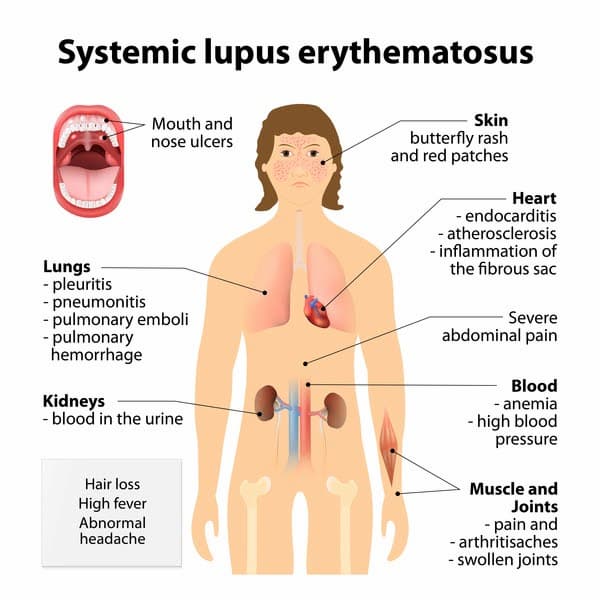Systemic lupus erythematosus (SLE) is an autoimmune disorder characterized by the immune system’s attack on healthy tissues throughout the body. This can affect various organs and systems, including the heart, kidneys, joints, lungs, and blood cells, resulting in diverse symptoms that can differ from person to person.
Innovative treatments like lupus stem cell transplant are emerging as promising options, seeking to reset the immune system and provide renewed hope for individuals battling this disease. Stem cell therapy offers the potential to slow down or even reverse the progression of lupus, offering patients the possibility of improved outcomes and quality of life.

The interest in stem cell therapy for lupus arises from the potential of stem cells to regenerate damaged tissues and modulate the immune system, thereby providing a novel treatment avenue that could address the root cause of the disease rather than just managing symptoms.
What Is Lupus Disease?
Lupus, or systemic lupus erythematosus (SLE), is an autoimmune disease where the immune system attacks the body’s own tissues, causing widespread inflammation and tissue damage in the affected organs. It can affect the joints, skin, brain, lungs, kidneys, and blood vessels, leading to a wide range of symptoms.
Lupus is characterized by its diversity of symptoms, which can range from mild to life-threatening.
What Are the Symptoms of Lupus?
Systemic lupus erythematosus usually comes with alternating severe and mild symptoms. Symptoms also vary widely among individuals and can flare up (worsen) and then go into remission. However, with treatment, people suffering from the disease can live normal lives.
Common symptoms include, but are not limited to:
- Joint pain and swollen joints;
- Severe fatigue;
- A characteristic rash called butterfly rash that occurs on the nose and cheek;
- Anemia;
- Hair loss;
- Dysfunctional clotting system;
- Shortness of breath;
- Dry eyes;
- Headache, confusion, memory loss;
- Tingling sensation of the fingers in cold weather; the fingers can also turn white or blue; a condition referred to as Raynaud’s phenomenon.
Some symptoms are specific to the body part being attacked, e.g., heart, skin, excretory and respiratory symptoms.
Get a free online consultation
Contact us to learn about the expected results of the treatment, its cost and duration.

Medical Advisor, Swiss Medica doctor
Causes of Systemic Lupus Erythematosus
The causes of this disease can be broadly grouped into five categories:
- Genetics (for example, ethnicity or health factors)
- Environment.
- Age.
- Sex and hormones.
Genetics
It has been established that SLE runs in families of those with the disease. The specific gene responsible has not been identified, but some genes have been associated with lupus. These genes show polymorphism and have been closely linked.
However, the degree to which they contribute to the development of the disease is still unknown. Genes in the Human leukocyte antigen (HLA) family have been associated with SLE since they form part of the immune system. Having a family member with lupus or another autoimmune disease increases the risk.
Environment
Environmental factors that can lead to systemic lupus erythematosus include ultraviolet rays, the use of certain medications, physical or emotional stress, viruses, trauma, infections, and exposure to certain types of chemicals, which can trigger lupus in genetically susceptible individuals.

Age
Certain age demographics exhibit a higher susceptibility to SLE, although the condition can manifest at any age. It predominantly affects individuals between the ages of 15 and 44, with younger individuals experiencing acute symptoms. Adolescents tend to display more mucocutaneous symptoms compared to older patients. Conversely, older individuals affected by SLE often face a heightened mortality risk due to the severe manifestations associated with late-onset.
Ethnic background
Data indicates varying susceptibility among different ethnicities to Lupus Erythematosus. Certain ethnic groups demonstrate a more favorable or unfavorable prognosis. People of Asian, African, and Native American descent are disproportionately affected compared to Caucasians, albeit with a relatively better prognosis in these groups. Caucasians with the condition typically succumb to complications such as cardiovascular and respiratory symptoms.
Sex and hormones
SLE exhibits a higher prevalence in females compared to males. Additionally, females tend to experience more severe complications, particularly during pregnancy and menstruation. These observations have led to speculation regarding the potential influence of sex and hormones on SLE development.
Diagnosis
Diagnosing lupus involves a combination of physical exams, laboratory tests, and a review of your medical history. The diagnosis can be derived from anamnesis, physical and instrumental examinations, and laboratory data. Detection of specific antigens in the blood (Antinuclear antibody (ANA) and anti-extractable nuclear antigen (anti-ENA)) can confirm the diagnosis.
Stem Cell Treatment for Lupus and Possible Forecast
Stem cell treatment for lupus involves using cells to reset the immune system, which can potentially lead to remission.
SLE affects people in different ways; therefore, lupus and stem cell treatment and lupus stem cell transplant are more effective when they are tailored to the patient.
Mesenchymal stem cell therapy differentiates into a variety of cell types and has immunomodulatory properties. They can be isolated from bone marrow, adipose tissue, umbilical cord blood, and other tissues. MSC therapy aims to repair damaged tissues and modulate the immune response, reducing inflammation and autoimmunity. Other treatments are:
- Corticosteroids
- Antimalarials such as hydroxychloroquine
- Immunosuppressants (methotrexate and azathioprine). Belimumad, human monoclonal antibody, is also used
- Analgesics (anti-inflammatory painkillers)
- Symptomatic and specific drugs, depending on the affected organs
- Cognitive behavioral therapy (CBT) is employed by support groups and professional counselors to help sufferers overcome depression, anxiety, and stress and to have positive mental health, which will help them live their lives normally.
What Is The Stem Cells Treatment Program for Lupus?
The stem cell treatment program for lupus includes the evaluation and preparation of the patient.
- Harvesting stem cells from the patient (autologous transplant) or a donor (allogeneic transplant).
- Checking cells for infections and the cultivation of healthy cells in the lab
- The transplantation process is followed by monitoring and support for immune system recovery.
Is Stem Cell Therapy for Lupus Safe and Effective?
Recent studies and clinical trials have shown promising results in using stem cell therapy for lupus. For instance, a study led by the Lupus Foundation of America’s (LFA’s) research awardee, highlighted the potential benefits of MSCs for the treatment of lupus. The majority of studies completed to date in mice assessing the use of MSCs for the treatment of lupus have reported improvements in kidney disease and life expectancy both before and after the development of lupus nephritis. The therapy also shows promise for the treatment of refractory lupus (a disease that’s resistant to treatment).
In some early clinical trials, people with refractory lupus responded well to MSC therapy, with some going into clinical remission and others seeing significant disease improvement. Some early clinical trials have found that people with refractory lupus respond well to mesenchymal stromal cells (MSCs) therapy, with some going into clinical remission and others seeing significant disease improvement.
However, as with any medical treatment, there are risks and potential side effects. It’s crucial to consult one of stem cell therapy professionals before considering this treatment.
Cost of Stem Cell Therapy For Lupus
The cost of stem cell therapy for lupus can vary widely depending on the treatment protocol, the country in which the treatment is performed, and whether the stem cells are autologous or allogeneic. In general, the cost will be between €7,000 and €25,000. We encourage you to consult with one of our professionals to determine the exact cost and the best course of treatment.
Conclusion
While stem cell treatment for lupus offers hope, each patient’s situation is unique, and treatments should be discussed with a knowledgeable healthcare provider. The potential of stem cell therapy in treating lupus is significant, but it’s also evolving, with ongoing research needed to fully understand its benefits and limitations.
Contact us
You can contact our Medical Advisor to find out about the expected results of stem cell treatment according to your case, its cost, duration, and some other details.

Medical Advisor, Swiss Medica doctor
List of References
Mesenchymal Stem Cell Therapy: Hope for Patients With Systemic Lupus Erythematosus; Front. Immunol., 30 September 2021 Sec. Autoimmune and Autoinflammatory Disorders https://www.frontiersin.org/articles/10.3389/fimmu.2021.728190/full
Aifen Li, Fengbiao Guo, Quanren Pan, Shuxian Chen, Jiaxuan Chen, Hua-feng Liu, Qingjun Pan
National Stem Cell Foundation, glossary https://nationalstemcellfoundation.org/glossary/lupus/
An overview of the safety, efficiency, and signal pathways of stem cell therapy for systemic lupus erythematosus; Volume 2021 | Article ID 2168595 https://www.hindawi.com/journals/sci/2021/2168595/
Qian Yang, Yiping Liu, Guangyong Chen, Wancong Zhang, Shijie Tang and Tianbiao Zhou
Medical Advisor, Swiss Medica doctor







